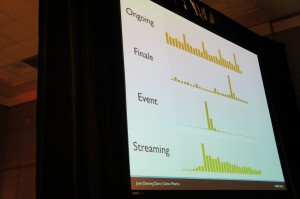 Graph showing Twitter activity by type of programming. The peaks occur during the live showing. Brands and programming can help drive the conversation beyond just the real time event, and some do this better than others as demonstrated by these graphs.
Graph showing Twitter activity by type of programming. The peaks occur during the live showing. Brands and programming can help drive the conversation beyond just the real time event, and some do this better than others as demonstrated by these graphs.
Real-time marketing. It is the current buzz phrase de jour, so of course it is being talked about at SXSW this week. And Oreo is currently #winning this approach: presenters can’t stop talking about how Oreo is responding to and engaging with customers, using its Super Bowl “dunk in the dark” tweet as the preeminent example. I even suggested a drinking game for every time it was mentioned:
There should be a drinking game for every time @oreo is mentioned @sxsw as great example of brand using digital/social well for engagement.
— Emily Reeves (@reeves501) March 9, 2013
And Oreo responded:
@reeves501 For every time you hear @oreo…DUNK it! #oreograbgo #sxsw
— Oreo Cookie (@Oreo) March 9, 2013
Yes, they are doing it right.
This morning, I sat in on a session titled “How Twitter Changed the Way We Watch TV.” While the bulk of the conversation was about the television programming, there was much discussion in the Q&A about how brands can capitalize on these opportunities. First a few stats:
- There are 400 million tweets a day.
- 1 in 3 twitter users have tweeted about TV.
- 41% of tablet 38% of smartphone owners use devices while watching TV.
- There were 24 million tweets about super bowl this year compared to 14 million last year. At its peak there were 232,000 tweets per minute.
Twitter is fantastic for engaging when everyone is watching something at the same time–sporting events, awards shows and reality TV (i.e., American Idol) are the prime example. However, cliffhanging dramas also garner this kind of engagement: Pretty Little Liars, a weekly teenage drama is the most tweeted show on television.
If a brand’s target audience aligns with these television programming’s target audience, it makes absolute sense for a brand to insert themselves into the conversation with RELEVANT contributions to the content of these shows in real time. This means someone from the brand actually watching the program in real-time and responding/posting to the activity on the television and tying it to the brand in some relevant way. This does not mean having scheduled generic brand posts set to go out during the programming. This takes staffing, money and commitment that a lot of brands aren’t ready to make yet, but looking at the success of Oreo could spur some action. And getting in on the action early can reap bigger benefits than being late to the game when consumers have moved on to the next thing.
The Bottom Line
Real-time marketing is real. And brands need to jump in on the conversations happening now.

